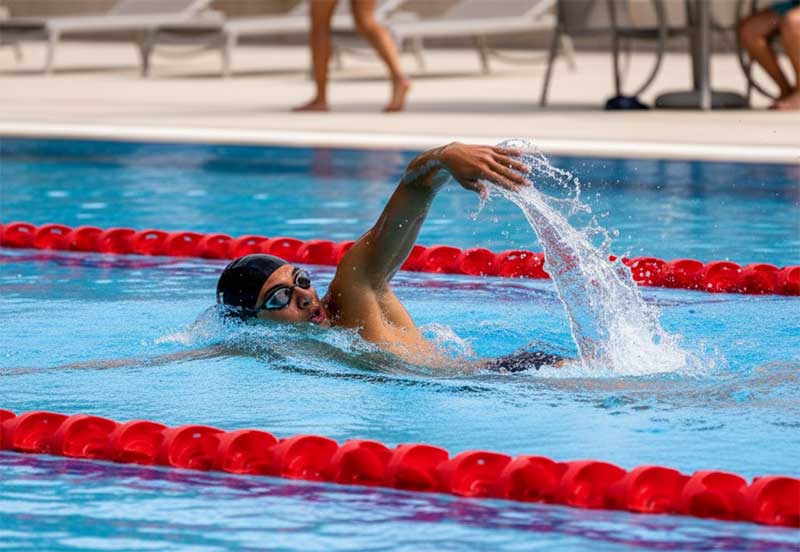I'll never forget the moment I heard the words: "You have a tibial stress fracture. You'll need to be on crutches for at least six weeks."
As someone who had just qualified for the Boston Marathon and was averaging 50+ miles per week, those words felt like a death sentence. Running wasn't just my hobby—it was my identity, my stress relief, my community, and my passion.
But that diagnosis in early September became the beginning of the most challenging and ultimately rewarding journey of my athletic career. This is my story of going from non-weight bearing crutches to crossing a 5K finish line in just 12 weeks.

From crutches to crossing the 5K finish line in 12 weeks
The Injury: How It Happened
Looking back, the warning signs were there. I had been ramping up my mileage too quickly while training for Boston, adding speed work and hill repeats without adequate recovery. My lower left leg had been aching for weeks, but I dismissed it as "shin splints" and kept pushing through.
The Breaking Point
During a 16-mile long run, the pain became unbearable around mile 12. Instead of stopping, I walked the remaining 4 miles, each step sending sharp, burning pain up my shin. By the time I got home, I could barely put weight on my leg.
An MRI two days later confirmed the diagnosis: a grade 2 tibial stress fracture in my left tibia, about 4 inches above the ankle. My orthopedic surgeon was clear: this required complete non-weight bearing for 6 weeks, followed by gradual return to activity.
Warning Signs I Ignored
- Progressive shin pain that got worse during runs instead of warming up
- Tenderness to touch in a specific spot on my shin
- Pain that persisted even after rest days
- Limping after runs and stiffness in the morning
- Increased mileage by 30% in just 3 weeks (way too fast)
If you're experiencing these symptoms, stop running immediately and see a doctor. I learned this lesson the hard way.
Weeks 1-6: Life on Crutches
The first week on crutches was humbling. Tasks I took for granted—carrying a cup of coffee, taking a shower, getting dressed—suddenly required careful planning and assistance. My upper body was exhausted from the constant crutch use, and my mental state hit rock bottom.
The Mental Struggle
As an endorphin-addicted runner, losing my primary coping mechanism for stress sent me into a spiral. I watched my running friends post their morning run selfies on social media while I sat on the couch, feeling my fitness slip away. Depression crept in during weeks 2 and 3.
Finding Alternative Exercise
My physical therapist and orthopedic surgeon agreed that maintaining cardiovascular fitness was crucial, as long as it was non-weight bearing. This became my lifeline.
My Crutches-Phase Workout Routine
- Pool Running (Aqua Jogging): 45-60 minutes, 5 days per week using a flotation belt
- Upper Body Strength: Push-ups, pull-ups, resistance band work 3x per week
- Core Stability: Planks, bird dogs, dead bugs 4x per week
- Single-Leg (Uninjured) Work: Balance exercises, squats, calf raises
Pool running became my salvation. It mimicked the running motion without impact and gave me that mental boost I desperately needed. I could "run" for an hour while keeping my cardiovascular system engaged.
Nutrition and Bone Health
My sports dietitian emphasized that nutrition would play a crucial role in bone healing. I focused on:
- Calcium-rich foods: Greek yogurt, leafy greens, fortified almond milk (1200mg daily)
- Vitamin D supplementation: 2000 IU daily (after blood work showed deficiency)
- Adequate protein: 1.2g per kg bodyweight to prevent muscle loss
- Anti-inflammatory diet: Reduced sugar and processed foods, increased omega-3s

Pool running and cycling maintained fitness during the non-weight bearing phase
Week 6: The Follow-Up X-Ray
Walking into my 6-week follow-up appointment, I was terrified. What if the bone hadn't healed? What if I needed more time on crutches?
When my doctor showed me the X-ray and said, "It's healing beautifully. You can start transitioning to a walking boot," I nearly cried with relief. I had followed every instruction to the letter, and my body had responded.
What Helped My Bone Heal Successfully
- 100% compliance with non-weight bearing instructions
- Optimal nutrition focused on bone health
- Quality sleep (7-9 hours nightly—this is when bones repair)
- Stress management (cortisol inhibits bone healing)
- No smoking or alcohol (both impair bone healing)
- Vitamin D sufficiency (corrected my deficiency early)
Weeks 7-9: Transition to Boot & Stationary Bike
The walking boot phase was both liberating and frustrating. I could finally walk again, but the boot was heavy, awkward, and made everything take twice as long.
Progressive Weight-Bearing Protocol
My PT designed a careful progression:
25% Weight Bearing
Walking with boot and one crutch, gradually increasing pressure on injured leg
- Started stationary bike at zero resistance (20 min sessions)
- Continued pool running 3x per week
- Balance and proprioception exercises
50-75% Weight Bearing
Walking with boot, no crutches for short distances
- Increased bike resistance gradually
- Added elliptical machine (low resistance, 15 min)
- Began single-leg strength work on injured leg
- Gait retraining exercises
Full Weight Bearing
Transitioned out of boot for 2-4 hours daily in supportive shoes
- Stationary bike: 30-40 min sessions with moderate resistance
- Elliptical: 20-25 minutes
- Walking: Started with 10-minute walks, 2x daily
- Strength training: Squats, lunges, calf raises
The Emotional Rollercoaster
Seeing light at the end of the tunnel brought both hope and anxiety. I was terrified of re-injury and hyper-aware of every sensation in my leg. Every small ache sent me spiraling into worry.
Mental Health Strategies That Helped
- Therapy: Working with a sports psychologist to process the injury
- Journaling: Tracking daily wins, no matter how small
- Community: Joining an online support group for injured runners
- Meditation: 10 minutes daily to manage anxiety
- Reframing: Seeing this as an opportunity to fix imbalances and weaknesses
Week 10: The First "Run"
At the end of week 9, my PT gave me the green light to begin a walk/run program. The plan was conservative, methodical, and designed to minimize re-injury risk.
The Walk/Run Protocol
I followed a modified Couch to 5K program, specifically adapted for stress fracture recovery:
Walk/Run Progression (Weeks 10-12)
That First Running Step
I'll never forget the feeling of that first 1-minute running interval. My pace was glacially slow—probably 12-minute miles—but it felt like flying. Tears streamed down my face as I realized I was actually running again.
The fear was real, though. Every footfall, I listened to my body, terrified I'd feel that sharp pain return. But it didn't. My leg felt strong, stable, and ready.
Rules I Followed Religiously
Return-to-Running Safety Rules
- Never increase time by more than 10% per week
- Take 2 rest days between running days (bike or swim on off days)
- Run on soft surfaces only (track, grass, treadmill)
- Stop immediately if any sharp pain appears
- Wear proper running shoes (got gait analysis and new shoes)
- Ice after every run for 15 minutes
- Continue PT exercises daily (hip strengthening, calf raises)
- Listen to body signals (soreness is okay, pain is not)

The triumphant return to running after weeks of patience and rehabilitation
Week 12: The 5K Race
When I registered for a local 5K at the end of week 12, my friends thought I was crazy. But I needed a goal—something concrete to work toward that would make all the pain and patience worthwhile.
Race Day
Standing at the starting line on a crisp December morning, surrounded by hundreds of runners, I felt a surge of gratitude I'd never experienced before. Six months ago, I couldn't walk. Now, I was about to run a 5K.
My goal was simple: finish without pain. Time didn't matter.
The gun went off, and I held myself back as faster runners surged ahead. I kept my pace conservative—about 9:30 per mile—and focused on form, breathing, and listening to my body.
Mile 1: Felt strong. Leg felt good. Kept checking in with every step.
Mile 2: Started to feel the effort, but it was normal running fatigue, not injury pain. Smiled at volunteers.
Mile 3: The finish line came into view. I picked up my pace slightly, letting emotion take over.
I cried. I hugged my physical therapist who came to watch. I texted my orthopedic surgeon a photo of my finish time. This wasn't just a 5K—it was a declaration that my running career wasn't over.
Lessons Learned: What This Journey Taught Me
1. Listen to Your Body (Before It Forces You To)
My stress fracture was 100% preventable. I ignored warning signs for weeks because I was obsessed with hitting arbitrary mileage goals. I've learned that rest days aren't weakness—they're strategic investments in longevity.
2. Injury Recovery Is Mental as Much as Physical
The psychological impact of losing your sport is devastating. Getting professional mental health support wasn't a luxury—it was essential. Sports psychologists understand the unique grief of athletic injuries.
3. Community Matters
Online support groups, understanding friends, and a great PT team made this journey bearable. Isolation would have broken me. Connecting with others who'd been through similar injuries gave me hope.
4. Cross-Training Saves Fitness
Pool running and cycling maintained 80%+ of my cardiovascular fitness. When I returned to running, I wasn't starting from zero. The investment in creative workouts paid enormous dividends.
5. Patience Is a Superpower
Every fiber of my being wanted to rush the process. But rushing stress fracture recovery leads to re-injury and longer time off. Slow is fast. Following the protocol meant I recovered fully rather than prolonging the injury.
6. Nutrition and Sleep Aren't Optional
I treated bone healing like a full-time job. Optimal nutrition, 8 hours of sleep, and stress management created the best possible healing environment. You can't out-physical-therapy a poor diet and sleep deprivation.
7. Identity Beyond Running
This injury forced me to confront my unhealthy attachment to running as my sole identity. I'm still a runner, but I'm also a coach, a friend, a writer, and a person who values balance. Diversifying my identity made me more resilient.
Red Flags That Required Immediate Medical Attention
If I had experienced any of these during my return-to-running, I would have stopped immediately:
- Sharp, localized pain in the previous fracture site
- Pain that worsens as a run progresses
- Limping or altered gait during or after running
- Pain that persists after stopping the activity
- Swelling, bruising, or tenderness to touch
Important: "Normal" return-to-running discomfort is muscle soreness and general fatigue. Bone pain is different—it's sharper, more localized, and specific to the injury site.
Where I Am Now (6 Months Post-Injury)
It's been 6 months since my diagnosis, and I'm now running 25-30 miles per week. I've completed three more 5Ks and a 10K. My times have improved, but more importantly, I'm running pain-free and smarter than ever.
Changes I've Made Permanently
- Mileage increases: Never more than 10% per week, ever
- Hard/easy pattern: No consecutive hard effort days
- Strength training: 2x per week hip and glute work (my weakness)
- Bone health nutrition: Daily calcium, vitamin D monitoring
- Rest days: 2 per week minimum, no negotiation
- Body awareness: I stop at the first sign of unusual pain
- Better shoes: Replace every 300-400 miles, professional gait analysis
- Cross-training: One bike or pool session per week always
Future Goals
My original goal of qualifying for Boston still stands, but now I have a healthier relationship with it. I'm targeting a fall marathon 18 months from now—giving my body plenty of time to build strength gradually.
More importantly, I want to help other injured runners navigate this journey. I'm working on coaching certification specifically for return-from-injury athletes.
Advice for Currently Injured Runners
If you're reading this from your couch with crutches beside you, here's what I want you to know:
- This is temporary. It doesn't feel like it now, but you will run again.
- Follow the protocol. Every shortcut extends your time away from running.
- Grieve the loss. It's okay to be sad, angry, and frustrated. Those feelings are valid.
- Find creative ways to move. Pool running saved my sanity and fitness.
- Build your team. PT, orthopedist, sports psychologist, supportive friends.
- Trust the process. Your body wants to heal. Give it the time and resources.
- Document your journey. You'll want to remember how far you've come.
You're not losing fitness—you're gaining wisdom, patience, and resilience that will make you a better athlete.
Final Thoughts
A stress fracture forced me to confront everything I was doing wrong as a runner: overtraining, ignoring pain signals, poor nutrition, inadequate recovery, and an unhealthy relationship with training goals.
The 12 weeks from crutches to 5K were the hardest of my running career. They were also the most valuable. I learned more about intelligent training, body awareness, and mental toughness than I did in 10 years of injury-free running.
I'm not grateful for the injury—I'd never wish that experience on anyone. But I'm grateful for the lessons. I'm a smarter, more balanced, and more resilient runner because of it.
If you're going through a similar journey, please know: You will run again. You will race again. And you'll be better for having gone through this.
About the Author
Sarah Mitchell is a recreational marathon runner based in Portland, Oregon. After recovering from a tibial stress fracture, she became passionate about helping other injured athletes navigate the physical and mental challenges of injury recovery. She's working toward coaching certification with a focus on return-from-injury programming. Follow her recovery journey on Instagram @runningsarahpdx.